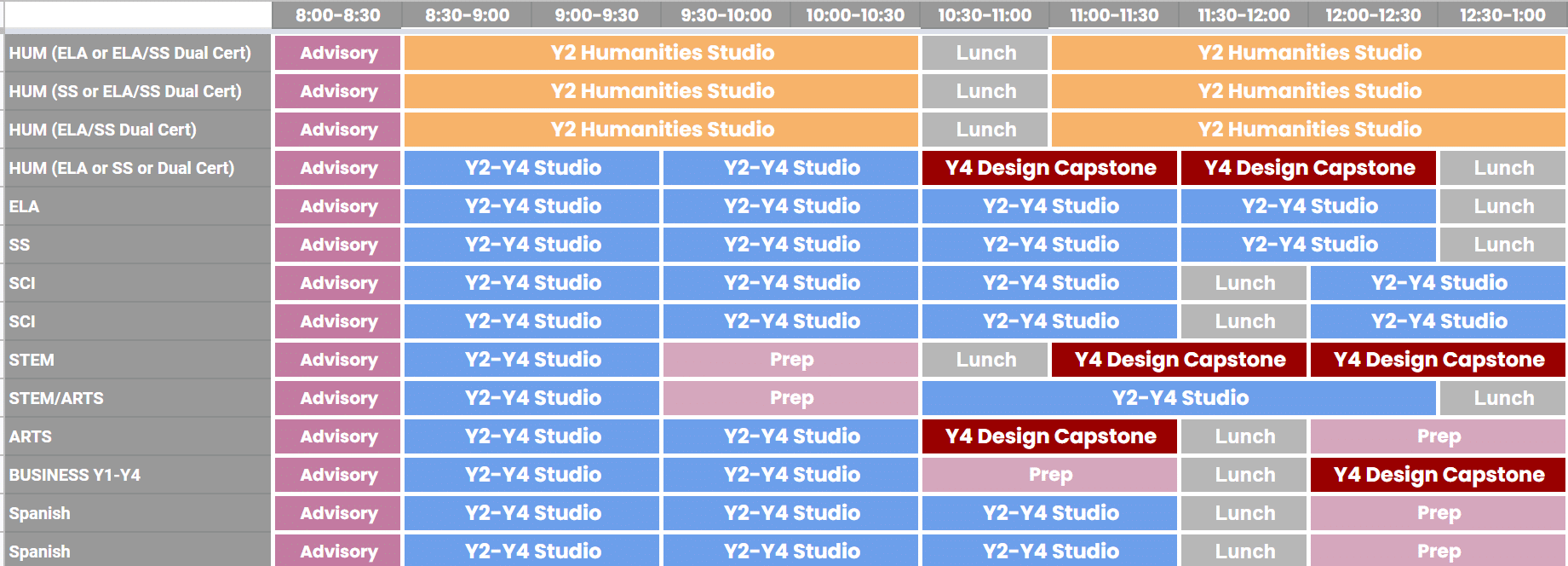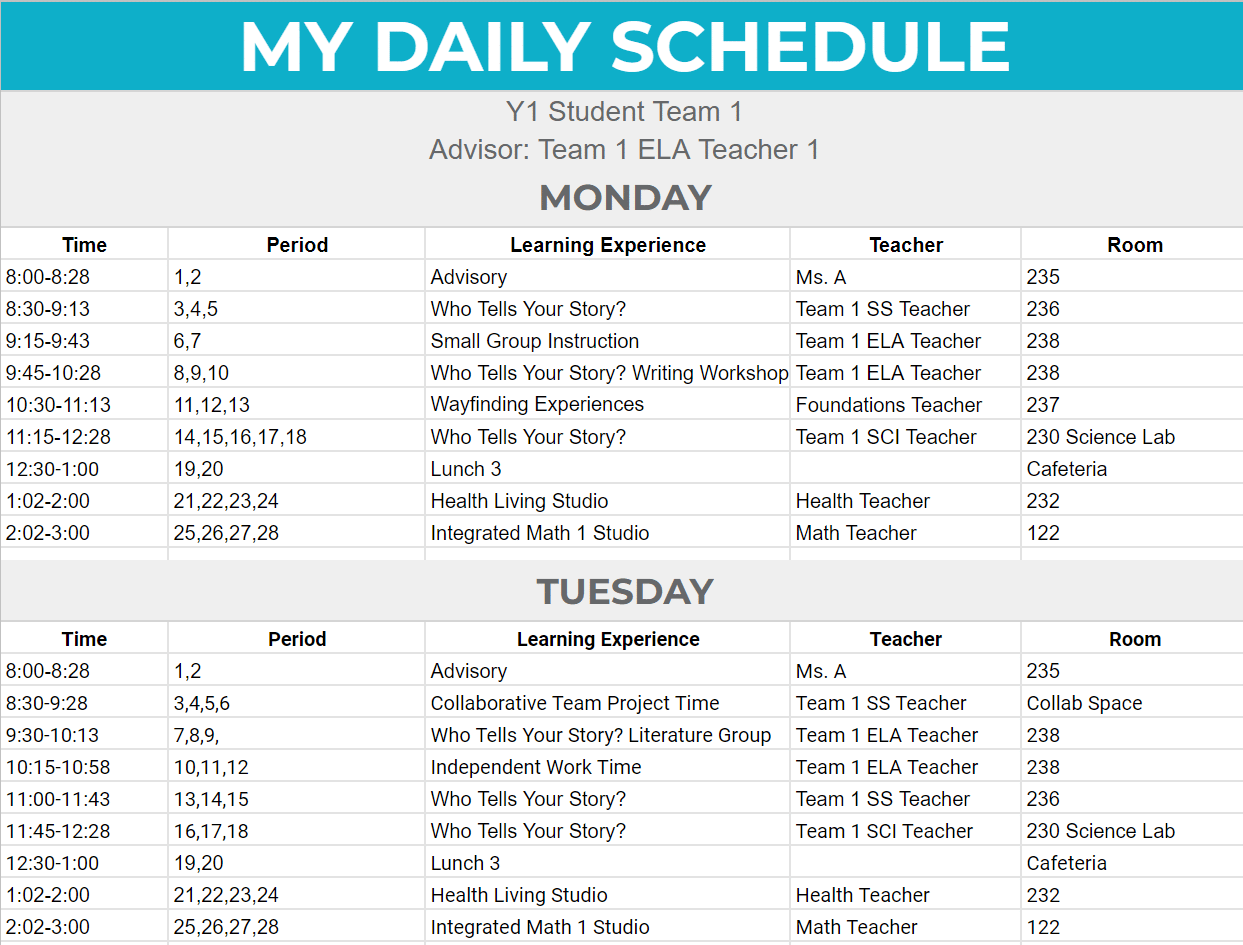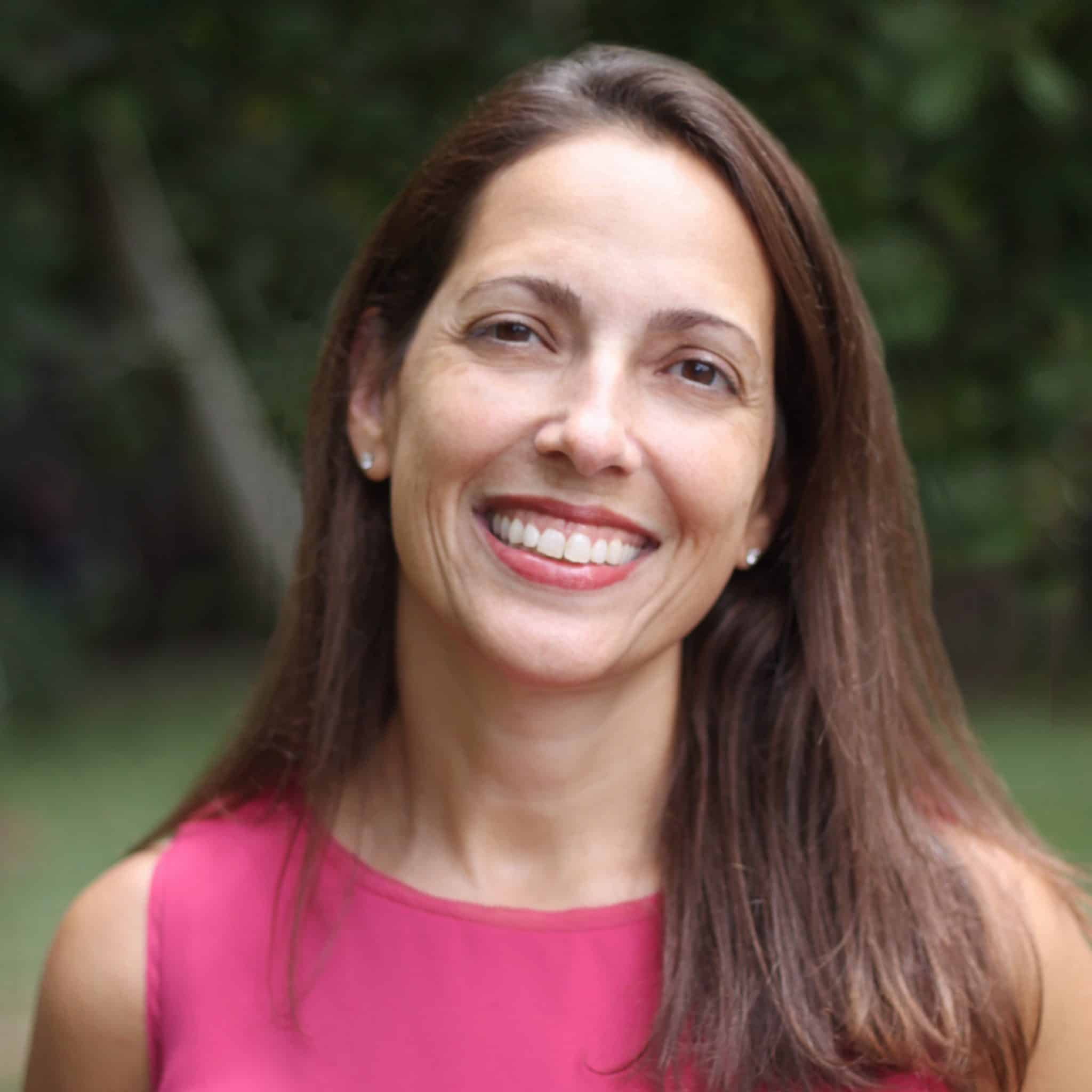Rethinking the Master Schedule in Competency-Based Schools
CompetencyWorks Blog
Links to other posts in this series by Sandra Moumoutjis are at the end of this article.
Time is one of the most valuable resources in our schools. We often think of time and schedules as fixed, but what happens when we shift our mindsets so that learning becomes the constant and time becomes the variable? Scheduling is an essential tool that, when used effectively, can break down traditional structures and improve learning outcomes for students.
There are many assumptions we make about what can and cannot be done with scheduling, so we need to start by challenging those assumptions. We also need to acknowledge that the current systems being used for scheduling are built to support these traditional structures and might be a barrier, so we need to be open to using additional systems or tools to achieve our desired schedules.
So how do we get started rethinking the master schedule? Of course, let’s start by asking ourselves, “Why?” Why is our daily schedule made up of seven or eight 42-minute periods? Why do we assign our students their courses based on grade levels? Why do we silo content in individual courses or by grade?
What and who drives the design of your master schedule?
The design of your master schedule should be guided by your goals and priorities for teaching and learning. How do you believe teaching and learning should be organized to maximize your resources and improve learning outcomes for students, and how can you redesign the master schedule to support those goals?
In my last blog post, I wrote about how competency-based education (CBE) is the structure you need to replace traditional course-based, grade-based, age-based, and time-based structures. Organizing teaching and learning around progression-based competencies allows you to mix students across grades, because students can be working on the same competencies, but at different levels. The content of the learning experience becomes the context through which students demonstrate their progress and growth on the competencies; therefore, content-based courses no longer need to be your organizing structure.
The first step in breaking down course-based structures requires you to rethink how and when students earn credits. In our Building 21 Allentown school, we use our Competency Framework to create competency-based portfolio credits that are earned upon completion of a portfolio, not based on seat time. This allows us to decouple the credits students earn in our Student Information System (SIS) from the learning experiences they participate in each day (this is explained more in my last blog post). This also requires us to build a master schedule outside of our SIS and create our own systems for student schedules and attendance.
When you begin the scheduling process, start with a working concept that reflects your priorities and goals. The next step is to shed assumptions (“we have always done it this way,” “this is the only way we can do it…,” etc.), and reimagine your schedule without the constraints of a time-based, age-based, course-based structure. For example:
Goal 1: Break down course structures for a more connected learning experience
Strategy: Create interdisciplinary teams that share the same teachers and students for a block of time every day. In this concept, the teachers and the students work together to create the schedules within that block of time based on students’ needs. The design of their interdisciplinary projects connects their learning and provides multiple opportunities for students to demonstrate their learning across competency areas (e.g., English language arts, social studies, science, nextgen essentials, habits of success).
Goal 2: Break down grade-based structures K-12 and provide students more choice in their learning.
Strategy: Create a schedule to allow for mixed-grade learning experiences for part or all of the day that students can choose or rotate through based on interest and the competencies they still need to work on in their portfolios.
Goal 3: Ensure teachers have collaborative planning time built into the schedule as well as additional personal and professional development time each week.
Strategy: Design a master schedule that provides teachers with collaborative planning time and release students two hours early once per week to support adult learning and development.
Perhaps, like us, your goal is to do all these things! To help you visualize this, we created a working scheduling concept that incorporates these goals and ideas. This concept is for a high school but you can easily adapt it for middle school and apply the same ideas to elementary school. Below, you will see a working concept of these scheduling ideas. Click here to access this scheduling resource and make a copy so you do not have to start from scratch!
Figure 1 – High School Scheduling Concept

Each day, this schedule starts with an Advisory block. Advisory is a way for us to create a connected community and ensure all students are known, cared for, and have an advocate working to both challenge and support them. Advisory groups can stay the same for all years, can be mixed-age groups, or can be grade-based in Year 1 and mixed-grades in Years 2-4, depending on your goals.
If students are experiencing CBE for the first time in 9th grade, they need support in making this transition. The image below shows first-year high school students in interdisciplinary teams for four hours of the day. We also have a Foundations teacher in these teaming blocks who supports Year 1 students in learning the CBE model, using technology for a variety of purposes and supporting students’ career-connected learning, exposure, and wayfinding experiences.
Figure 2 – Interdisciplinary Teaming Block for Year 1 Students

After Year 1, this scheduling concept allows students to be mixed throughout learning experiences, which for us are called “studios” (read my blog post about Building 21’s Studio Model for more information).
Figure 3 – Mixed Grade-Level Studios

Once you have a scheduling concept, you can innovate within that concept. This concept is based on 30-minute periods. It can easily be adapted to 15-minute periods to allow for variations in the time of experiences. This schedule also allows for teaming structures across learning experiences. You can team English language arts and social studies teachers for humanities blocks or science and math teachers for STEM blocks. You could have some requirements within the schedule. Maybe you want all Y2 students to rotate through the same set of humanities studios or you want every student in their final year to complete a design capstone, as shown below. Once you build the concept, the possibilities are endless!
Figure 4 – Grade-Level Specific Requirements: Humanities Studio Rotation for Year 2 Students and Design Capstone for Year 4 Students

As I mentioned before, there are limitations to building an innovative and flexible master schedule in a traditional SIS. Usually, you are only allowed to build one schedule for a school year and students have to be scheduled for everything at the start of the year. Also, you are usually scheduling courses that need grades entered at the quarter, semester, or end of the year to earn credits.
We created a scheduling system in Google Sheets to schedule and reschedule students as needed within teams and across learning experiences.
Figure 5 – Google Sheets Scheduler

Teachers can choose from drop-down boxes in each period that show the learning experience, teacher, and room number. There can be a tab for each day or a row for each day, or the same schedule two days per week.
This same tool can also be used to schedule all learning experiences every six weeks, every ten weeks, by quarter, or by varied amounts of time based on the experience.
The scheduling tool then populates the “My Schedule” tab in the student’s Personalized Learning Plan (PLP). When teachers or counselors make a scheduling change, they can push out those changes and students’ PLPs will immediately start updating.
Figure 6 – Student Schedule in Personalized Learning Plan

On Wednesdays, we release students two hours early in order to provide dedicated time for personal and professional learning for staff. On an early dismissal day, you can run your same schedule with shorter periods, or you can use the day for a different set of learning experiences. Maybe on your early dismissal days you provide opportunities for mixed-grade learning experiences or rituals such as town hall meetings. Or you can use the day for extended advisory and flex scheduling.
Another idea is to involve the community and explore other learning experiences both within and outside of the school. Some schools arrange for all students to be involved in the community for a half day every week through job shadowing, internships, and community services opportunities. Other schools bring in organizations to support learning experiences that they do not offer, such as art, music, theater, or career exposure opportunities. The following example shows a Wednesday schedule that incorporates career exposure, community involvement, and building community through town hall meetings:
Figure 7 – Student Wednesday Schedule in Personalized Learning Plan

A big part of implementing competency-based innovations is to change the way we work within and outside of traditional systems.There are ways to innovate within traditional systems to build schedules for the experiences that students are in, as well as the credits they are earning. In our Allentown School, we are now working with the district to develop “ghost” schedules in our SIS that allow us to create and roster students to a non-credited course for each learning experience to show where they go in a day and to facilitate daily attendance. Some scheduling systems allow for arena scheduling, which gives students a window of time to pick the studios (or courses) they are interested in taking. There are several scheduling systems and apps that will provide you with options for flexible scheduling of your students outside of traditional systems. Eduspire Solutions offers a Flex Time Manager, which allows for daily personalized schedules for students. Enriching Students has Flexible Student Scheduling, which allows you to customize flex blocks or manage time within a larger block to create personalized student schedules within those blocks.
My next blog post will focus on some of the barriers created by traditional tracking systems and will provide examples of competency-based tracking systems and innovative data dashboards to transparently track and communicate progress and growth in a competency-based model. In the meantime, challenge yourself to revisit your master schedule and find one way you can use scheduling and CBE to reimagine teaching and learning in your school!
Learn More (other posts in this series)
- Why Should Schools Transition to Competency-Based Education?
- Preparing for Your Competency-Based Education Journey: A Process for Success
- Building 21’s Teacher Competencies to Facilitate Competency-Based Learning
- Building 21’s Leadership Competencies to Facilitate Competency-Based Learning
- Building 21’s Studio Model: Designing Learning Experiences for Engagement and Impact
- Replacing the Grammar of Schooling with Competency-Based Innovations
 Sandra Moumoutjis is the Executive Director of Building 21’s Learning Innovation Network which is designed to grow and support a community of schools and districts as they transition to competency-based education. Through professional development and coaching, Sandra supports schools and districts in all aspects of the change management process. Sandra is the co-designer of Building 21’s Competency Framework and instructional model. Prior to working for Building 21, Sandra was a teacher, K-12 reading specialist, literacy coach, and educational consultant in districts across the country.
Sandra Moumoutjis is the Executive Director of Building 21’s Learning Innovation Network which is designed to grow and support a community of schools and districts as they transition to competency-based education. Through professional development and coaching, Sandra supports schools and districts in all aspects of the change management process. Sandra is the co-designer of Building 21’s Competency Framework and instructional model. Prior to working for Building 21, Sandra was a teacher, K-12 reading specialist, literacy coach, and educational consultant in districts across the country.